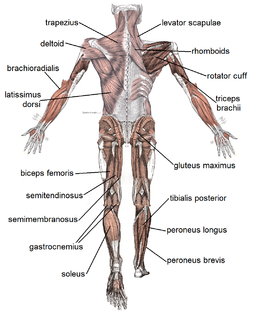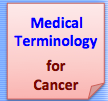Medical Terminology for Cancer
© Copyright 1996-2013
7: The Muscular System
Contents
 Functions of muscles
Functions of muscles Characteristics of muscle tissue
Characteristics of muscle tissue Types of muscles
Types of muscles Examples of muscles
Examples of muscles Muscle movements
Muscle movements Roots, suffixes, and prefixes
Roots, suffixes, and prefixes Cancer Focus
Cancer Focus Related Abbreviations and Acronyms
Related Abbreviations and Acronyms Further Resources
Further ResourcesFunctions of muscles
The main function of muscles is for motion, for example in conjunction with bones for walking. Many muscles work in groups but some may work alone e.g. the diaphragm for breathing, and the heart for circulating blood.Characteristics of muscle tissue
- Irritability
- (excitability) muscles receive and respond to stimulation.
- Contractability
- allows muscles to change shape to become shorter and thicker.
- Extendibility
- living muscle cells can be stretched and extended; longer and thinner.
- Elasticity
- once the stretching force is removed a living muscle cell retains it's original shape.
Types of muscles
Different types of muscle respond, contract, and relax at different rates.
- Skeletal muscles
- are striated (have distinct bands) made up of fibres (long cells). The cells are multinucleated (many cell nuclei) and contract and relax quickly. These are voluntary muscles attached to the skeleton that help to move the bones. There are nearly 700 skeletal muscles spread all over the body.
- Visceral muscles
- are smooth and without banding. They have short fibres and single cell nuclei. These are involuntary muscles e.g. found in walls of blood vessels and viscera (organs in the abdominal cavity).
- Cardiac muscles
- are striated (but less distinct than skeletal muscles), and are involuntary .
Examples of muscles
- The diaphram
- is the major muscle for breathing (respiration). The diaphragm is located in the rib cage below the lungs. It is a dome shaped muscle that pulls / pushes air in and out of the lungs. 'Hiccups' are a spasm of the diaphragm.
- Intercostals
- also aid respiration Inter- (between) Costals (ribs). Internal intercostals lift the ribs during respiration, whilst external intercostals draw the ribs together during expiration to lessen the volume of the rib cage and thoracic cavity to push air out of the lungs.
- Biceps and triceps
- are antagonist(have the opposite functions). Triceps (with three 'heads') extend the forearm so it can be held straight, while biceps (two 'heads') flex the forearm and draw it up.
- Tendons
- connect muscles to the bone, these are formed from the connective tissue that cover the muscle. They are dense white cords of tissue which are strong and flexible, they serve to anchor muscles to the bone.


Selected major muscles: anterior (left) and posterior (right). Images c/o Wikimedia.
Muscle movements
Most movements involve several skeletal muscles working together. Most skeletal muscles are arranged in opposing pairs at joints, for example one muscle tightens up while the other extends.
- Flexors
- tighten to decrease the angle of a joint
- Extensors
- relax to increase the angle of a joint
- Abductors
- move a bone away from the midline
- Adductors
- move a bone toward the midline
- Levators
- make an upward movement
- Depressors
- make a downward movement
- Supinators
- turn the palm upwards or inwards
- Pronators
- turn the palm downwards or outwards
- Sphincters
- decrease the size of an opening
- Tensors
- makes part of the body more rigid
- Rotators
- moves a bone around
Roots, suffixes, and prefixes
Most medical terms are comprised of a root word plus a suffix (word ending) and/or a prefix (beginning of the word). Here are some examples related to the Muscles. For more details see Chapter 4: Understanding the Components of Medical Terminology
| component | meaning | example |
| SARC- | tissue | sarcoma = tumour of supportive tissues (muscle, bone etc.) |
| INTRA- | into | intramuscular injection = injection into a muscle |
| MYO- | muscle | myocardium = heart muscle |
| BI- | two | biceps = muscles with two heads |
| TRI- | three | triceps = muscles with three heads |
Cancer Focus
- Rhabdomyosarcoma
- Rhabdomyosarcoma is a malignant tumour of striated muscle
found in children and young adults.
Rhabdomyosarcoma accounts for about two thirds of childhood soft
tissue sarcomas. There are 3 broad histological sub-types:
- Embryonal rhabdomyosarcoma occurs maily in infants and young children, usually arising in the head, neck or genitourinary system (especially the testis, prostate, vagina, and bladder).
- Alveolar rhabdomyosarcoma is most common in adolescents and young adults, mostly found in peripheral muscles.
- Pleomorphic rhabdomyosarcoma is most common in adults, usually found in the muscles of the extremities in adults.
 Internet Resources for Rhabdomyosarcoma
Internet Resources for Rhabdomyosarcoma
- Other types of Soft Tissue Sarcoma
- Other types of cancer affecting muscles and soft tissues include:
fibrosarcoma (begins in fibrous tissue in the arms and legs)
neurofibrosarcoma (begins in nerves near the surface of arms, legs, and trunk)
leiomyosarcoma (muscles in the trunk)
liposarcoma (begins in fat in the arms and legs)
synovial sarcoma (begins in linings of joint cavities and tendon sheaths)
hemangiopericytoma (begins in blood vessels in the arms, legs, trunk, head,and neck).
alveolar soft part sarcoma (begins in nerves of the muscles in the arms and legs)
malignant fibrous histiocytoma (begins in fibrous tissue). Internet Resources for Soft Tissue Sarcoma
Internet Resources for Soft Tissue Sarcoma
- Potential Side Effects of Radiotherapy on Muscles
- Muscles can be damaged by radiotherapy which can cause fibrosis, muscle shortening and atrophy. Any potential side effects will depend on the site of the tumour, the patients age, and the dose of radiotherapy. For example high dose radiotherapy in may result in footdrop which is a condition where the anterior muscles of the leg are paralysed. Second malignancies particularly fibrosarcomas can also develop in previously irradiated sites.
Related Abbreviations and Acronyms
| ARMS | Alveolar rhabdomyosarcoma |
| IM | Intramuscular - into a muscle |
| MPNST | Malignant Peripheral Nerve Sheath Tumour |
| NRSTS | Non-Rhabdomyosarcoma Soft Tissue Sarcoma |
| RMS | Rhabdomyosarcoma |
Further Resources (4 links)
 Muscle Names Have Meaning
Muscle Names Have Meaning
Kevin Patton
Learning muscles is hard enough without dealing with those crazy convoluted Latin names. But if you pay attention to those names, you'll find that they are actually phrases that help you find the muscles AND help you to remember them in the long term. Find out how this works ... and where to find lists to help you figure out the meaning of common muscle names.
SEER, National Cancer Institute
Part of a SEER training module for cancer registry staff.
 Muscular System - Self Test questions
Muscular System - Self Test questions
WebAnatomy, University of Minnesota
Test your anatomy knowledge with these interactive questions. Includes different question types and answers.
 The Muscular System
The Muscular System
Paul Andersen
Paul Andersen explains the three types of muscle found in humans; striated, smooth and cardiac muscle. He explains how actin and myosin interact to contract the sarcomere in a muscle. The sliding filament theory explains how ATP and calcium are used to contract the z disks.



This guide by Simon Cotterill
First created 4th March 1996
Last modified: 1st February 2014

 CancerIndex
CancerIndex